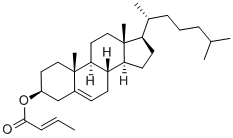DECYL ACRYLATE
- CAS NO.:2156-96-9
- Empirical Formula: C13H24O2
- Molecular Weight: 212.33
- MDL number: MFCD00048400
- EINECS: 218-462-9
- SAFETY DATA SHEET (SDS)
- Update Date: 2024-12-18 14:08:52

What is DECYL ACRYLATE?
Synthesis Reference(s)
Journal of the American Chemical Society, 118, p. 7716, 1996 DOI: 10.1021/ja9610287
General Description
Liquid. Less dense than water and insoluble in water. Hence floats on water.
Air & Water Reactions
Insoluble in water.
Reactivity Profile
DECYL ACRYLATE reacts exothermically with acids to give n-decyl alcohol and acrylic acid. May react vigorous with strong oxidizing acids and generate enough heat to ignite the reaction products. Interaction with caustic solutions also generates heat. Incompatible with alkali metals and hydrides. Polymerizes readily in the presence of heat and light generating much heat. [Handling Chemicals Safely, 1980. p. 250]. Burns to give acrid smoke and fumes that contain toxic acrylic acid, one of the most serious eye injury chemcials and a severe skin irritant.
Health Hazard
INHALATION: Higher concentrations may cause pronounced pulmonary irritation or edema. Prolonged contact may cause severe damage to tissues. May be fatal if swallowed or absorbed through skin.
Properties of DECYL ACRYLATE
| Melting point: | -69°C (estimate) |
| Boiling point: | 158°C 50mm |
| Density | 0,878 g/cm3 |
| refractive index | 1.4363 (estimate) |
| storage temp. | Keep in dark place,Inert atmosphere,Room temperature |
| color | Clear, colourless |
| EPA Substance Registry System | Decyl acrylate (2156-96-9) |
Safety information for DECYL ACRYLATE
| Signal word | Warning |
| Pictogram(s) |
 Exclamation Mark Irritant GHS07 |
| GHS Hazard Statements |
H315:Skin corrosion/irritation H317:Sensitisation, Skin H319:Serious eye damage/eye irritation |
| Precautionary Statement Codes |
P261:Avoid breathing dust/fume/gas/mist/vapours/spray. P264:Wash hands thoroughly after handling. P264:Wash skin thouroughly after handling. P272:Contaminated work clothing should not be allowed out of the workplace. P280:Wear protective gloves/protective clothing/eye protection/face protection. P302+P352:IF ON SKIN: wash with plenty of soap and water. P305+P351+P338:IF IN EYES: Rinse cautiously with water for several minutes. Remove contact lenses, if present and easy to do. Continuerinsing. P333+P313:IF SKIN irritation or rash occurs: Get medical advice/attention. P337+P313:IF eye irritation persists: Get medical advice/attention. |
Computed Descriptors for DECYL ACRYLATE
New Products
(S)-3-Aminobutanenitrile hydrochloride 4-Methylphenylacetic acid N-Boc-D-alaninol N-BOC-D/L-ALANINOL Tert-butyl bis(2-chloroethyl)carbamate 3-Morpholino-1-(4-nitrophenyl)-5,6-dihydropyridin- 2(1H)-one Furan-2,5-Dicarboxylic Acid Tropic acid 1-Bromo-3,5-Di-Tert-Butylbenzene S-2-CHLORO PROPIONIC ACID ETHYL ISOCYANOACETATE 2-Bromo-1,3-Bis(Dimethylamino)Trimethinium Hexafluorophosphate 4-IODO BENZOIC ACID 3-NITRO-2-METHYL ANILINE 1-(2,4-DICHLOROPHENYL) ETHANAMINE (2-Hydroxyphenyl)acetonitrile 4-Bromopyrazole 2-(Cyanocyclohexyl)acetic acid 4-methoxy-3,5-dinitropyridine 1-(4-(aminomethyl)benzyl)urea hydrochloride 2-aminopropyl benzoate hydrochloride diethyl 2-(2-((tertbutoxycarbonyl)amino) ethyl)malonate tert-butyl 4- (ureidomethyl)benzylcarbamate Ethyl-2-chloro((4-methoxyphenyl)hydrazono)acetateRelated products of tetrahydrofuran








You may like
-
 2033-24-1 98%View Details
2033-24-1 98%View Details
2033-24-1 -
 42831-50-5 5-METHYLISOXAZOLE-4-CARBOXYLIC ACID 98%View Details
42831-50-5 5-METHYLISOXAZOLE-4-CARBOXYLIC ACID 98%View Details
42831-50-5 -
 1975-50-4 98%View Details
1975-50-4 98%View Details
1975-50-4 -
 2-HYDROXY BENZYL ALCOHOL 98%View Details
2-HYDROXY BENZYL ALCOHOL 98%View Details
90-01-7 -
 2-Chloro-1,3-Bis(Dimethylamino)Trimethinium Hexafluorophosphate 221615-75-4 98%View Details
2-Chloro-1,3-Bis(Dimethylamino)Trimethinium Hexafluorophosphate 221615-75-4 98%View Details
221615-75-4 -
 61397-56-6 CIS BROMO BENZOATE 98%View Details
61397-56-6 CIS BROMO BENZOATE 98%View Details
61397-56-6 -
 14714-50-2 (2-Hydroxyphenyl)acetonitrile 98+View Details
14714-50-2 (2-Hydroxyphenyl)acetonitrile 98+View Details
14714-50-2 -
 118753-70-1 98+View Details
118753-70-1 98+View Details
118753-70-1